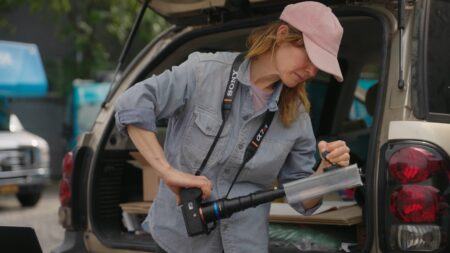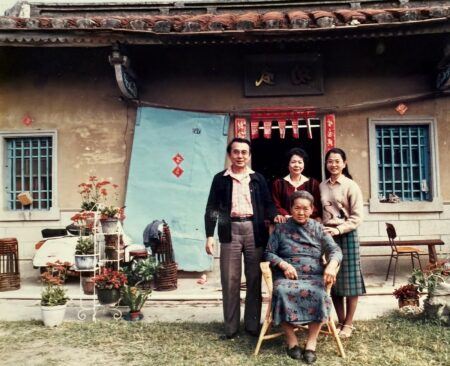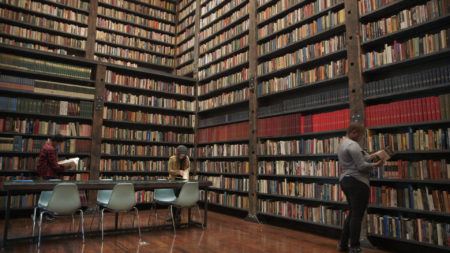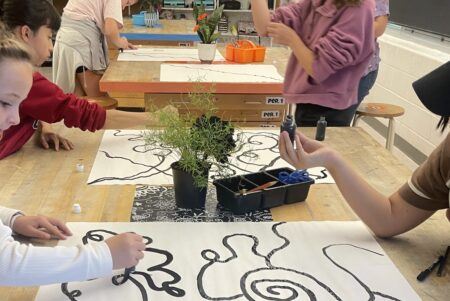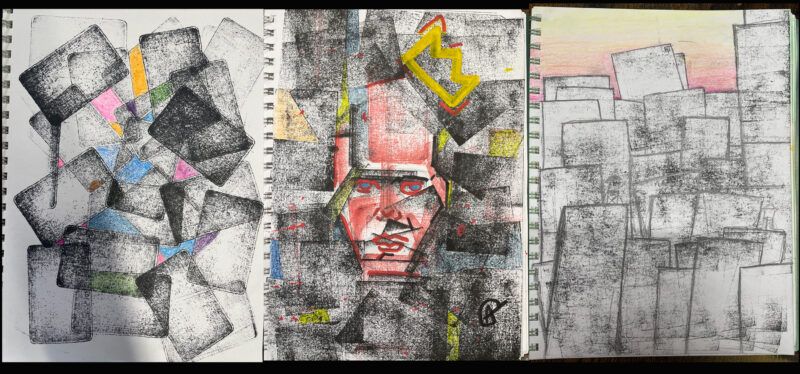
Three different student artworks using stamp pads and various drawing media, inspired by Cubism, Jordan Casteel, and MadC. Courtesy of Gregg Emery.
“Argh! That painting is exactly why I hate modern art!” “What is it?!” And my personal favorite (written while giving my best middle school eye roll): “I could do that.” We have all heard these disparaging comments in regards to works of art, definitely directed at most contemporary work but also in regards to works by Cézanne, af Klint, Mondrian, and more. If you are an art educator you do your best to skillfully shift the conversation back to the task at hand. Or if you are having this conversation over dinner with your peers or family, perhaps just a laugh or a definitive “Yes, it is art” and the dinner continues. However, none of these questions or, in my case, attempts to connect students (and adults) to the meaning, experience, and power of contemporary artists and art practices really seem to take hold in a concrete or sustainable way.
Most recently, I have been working on exploring the possibility of encouraging my 7th and 8th graders to approach new and different works with curiosity and wonder rather than skepticism, or worse: utter and complete dismissal and revulsion! My foundation begins by pairing a ‘known’ modern artist with a living contemporary counterpart. We spend time getting to know the works, world and process of both artists with the goal of finding ways to create an original artwork inspired by the two. I stress with my students, and with you here now, that it is not an exercise in illustration or copying the aesthetic hallmarks of a certain artist. The goal is rather to learn about what inspires and motivates an artist in the hope that it will generate new ways of working and thinking for my students.
While attending my first Art21 Educators Summer Institute, an early icebreaker challenged educators to gather in groups and write the name of at least one contemporary artist next to each letter of the alphabet, corresponding with the first letter of their last name (ie. Abramović, Bourgeois, Casteel, Drew). I realized this would be a fantastic way to help students remember artists as well as keep them engaged.
Keep in mind, there are many other skills, vocabulary, and simple art historical facts I am putting in place along the way but the basic structure of this particular class, that I was fortunate enough to be able to create and teach, is as follows: I introduce two (or more) artists who share the same letter of their last name. Some of my pairs have been Paul Cezanne & Jordan Casteel, Salvador Dalí & Leonardo Drew, Helen Frankenthaler & Walton Ford, Andy Goldsworthy & the Gutai Movement, and Barbara Kruger & Yayoi Kusama. As you can see, it doesn’t necessarily have to be a modern artist paired with a contemporary one, although we do start by defining each of those designations too.
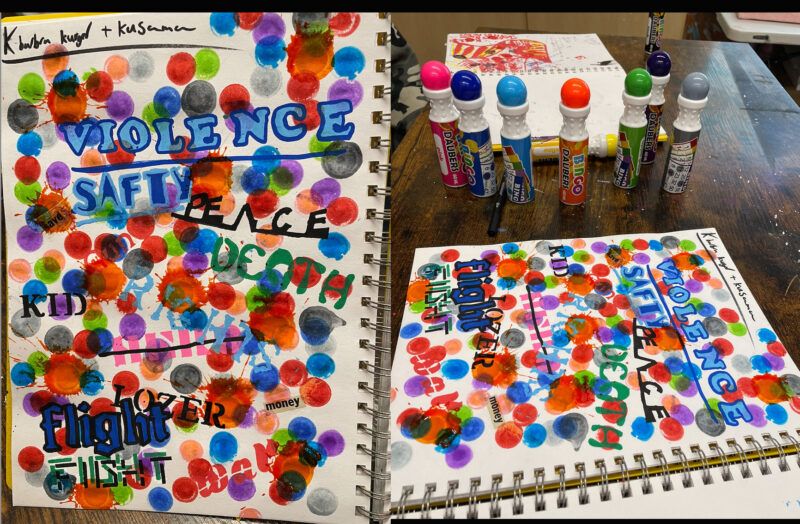
While watching Art21’s Extended Play film featuring Barbara Kruger, students were asked to write down at least 5 words or phrases that caught their attention. We then watched a trailer for the biopic on Yayoi Kusama, Kusama: Infinity, and used bingo daubers to create these pieces. Courtesy of Gregg Emery.
Many of these projects are done in a handmade sketchbook that students create in our early days and others are done outside of this self-made container. For instance, for our Dalí/Drew piece students are given a wooden panel and are prompted to use small wood scraps and build both a ‘surreal scene’ as well as explore with the shapes to build texture, pattern, and a surface that projects. As a starting point, each member of the ‘Making Modern Art’ class decided on a horizon line which on one side was a ‘surrealist landscape’ and on the other was a build-up of various wood pieces and 3D objects. We watched a bit of both artists’ process with the help of online videos and images. The Art21 video from Season 7 featuring Leonardo Drew reveals his art practice in his studio where he goes to work, “not knowing what the works are going to be about but they find their way.” This improvisational method that leads to finding meaning gives students permission to seek without predetermined results but then to consider and establish purpose as they ‘resolve’ the artwork.

Student three-dimensional responses to Salvador Dalí and Leonardo Drew. Courtesy of Gregg Emery.
In another session, ideation began after watching a video of Helen Frankenthaler pouring and directing paint on a canvas and then followed this with the work and words of Walton Ford from an exhibition at The Morgan Library & Museum here in New York. Ford uses animals as the main players in his painted scenes and students were encouraged to build a surface of color in which they would add their animal inspiration from a story, recent news, or movies into their work. One student allowed their work on the previous project with Olafur Eliasson to ‘spill over’ into the Ford/Frankenthaler session with recurring shapes and color palettes in which small animal silhouettes wove their way in and out of the composition.
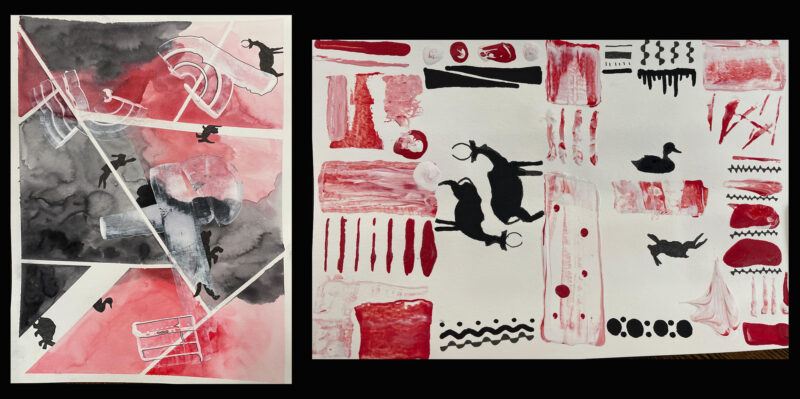
Middle School student artwork, three variations inspired by Helen Frankenthaler & Walton Ford. Courtesy of Gregg Emery.
What is also great about this practice is that, besides learning from great artists of yesterday and today, students are also not putting one group or artist or time period up on a pedestal. Figuration and naturalistic detail are starting to be seen as an approach and not the ultimate goal or finish line for what a great artwork is. Learning and finding our place in this expansive family of artists is vitally important for artists of any age. I have also witnessed students learning to take risks and chances with these inspired pieces that they weren’t taking with their own work and in many cases they have asked to do more iterations and pieces based on the questions and explorations from previous challenges.
I find the most rewarding moments are when students discover an innate ‘self-motivation’ and ask to keep working back into and over a project, simply try more variations, or find an affinity with an artist or way of working. Lastly, my original goal for this class–to see if it was possible to get students to become more curious about contemporary art and artists and less dismissive–was definitely met. This class encourages curiosity, and encourages students to jump in moments of discovery. It doesn’t take long for students to want to know more about other artist’s lives, work, and methods, which encourages positive questions about the work of their peers. Now, if I could only make a dinner party version of this approach, I might be able to help my friends and family too.
Gregg Emery is an artist, art educator and creative leader with nearly 30 years of experience in K-12 art education. I have always focused on both artmaking and teaching and how the two can feed one another for the benefit of the students and larger community. My focus in both fields has always been that of a life-long learner whose focus on collaboration and connection has led to innovation in meaningful and purposeful ways. Currently, I teach visual art to grades 7-12 at the Trinity School in New York City.
Recent exhibits of my drawing, paintings and collaborations include a solo show in Brooklyn, a group show with Young Soy gallery of Hong Kong as well as shows in New York, Amsterdam, Chicago and Miami for Art Basel. My work is a part of private and public collections around the world including the permanent collection of White & Case, Aston Martin, American Copper Building, Jack Daniels and the Baltimore Museum of Art. I also serve on the Board of Directors for the Poetry Society of New York and have been an Art21 Educator for the past 3 years.
